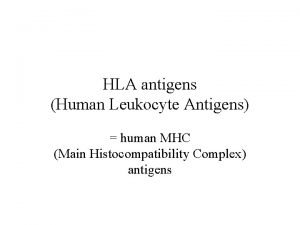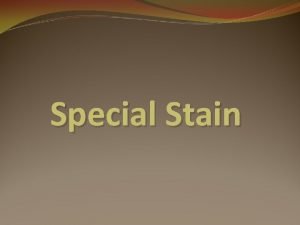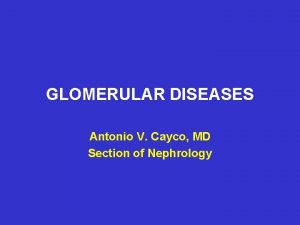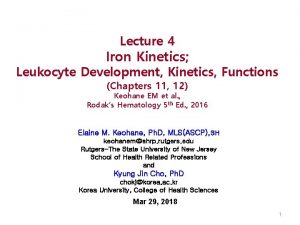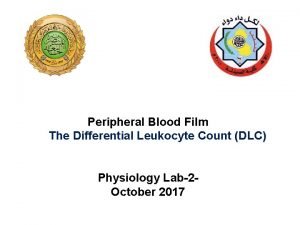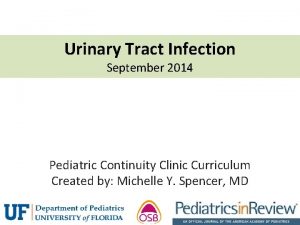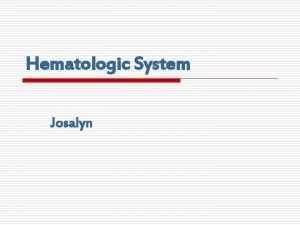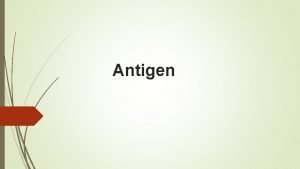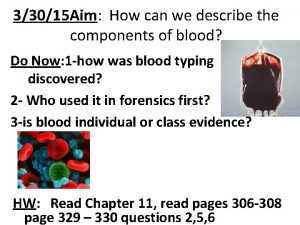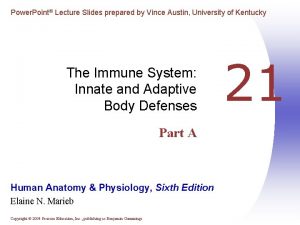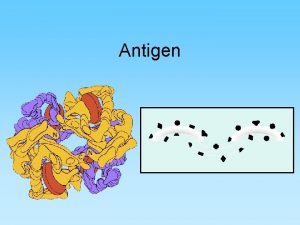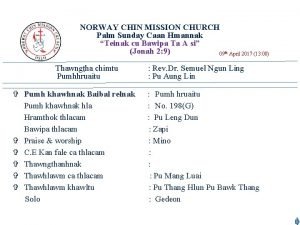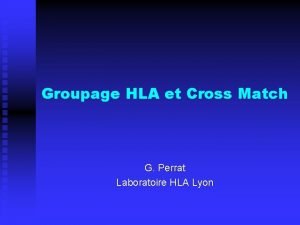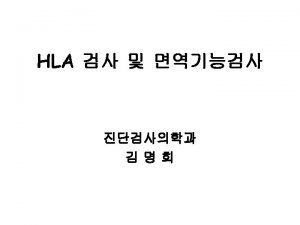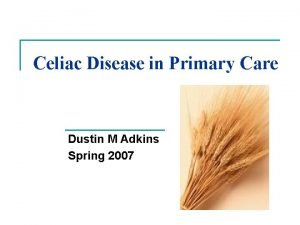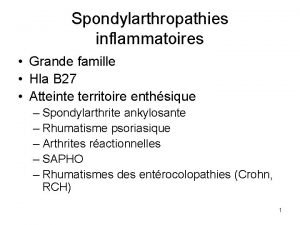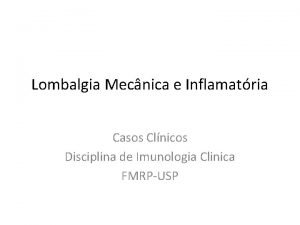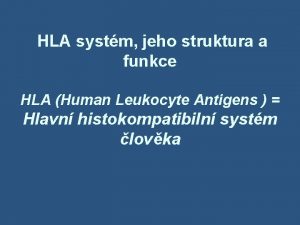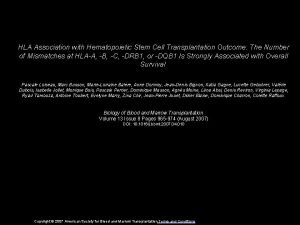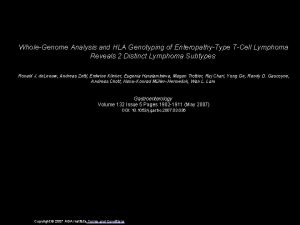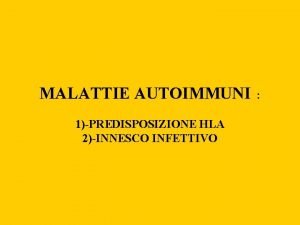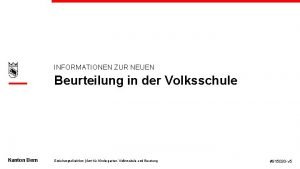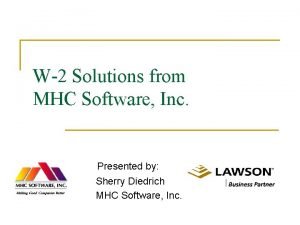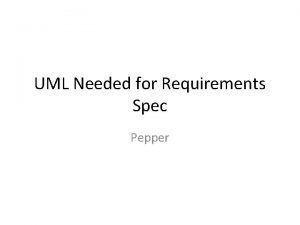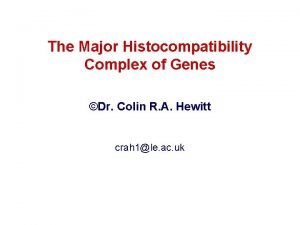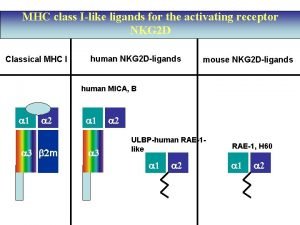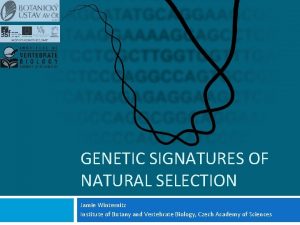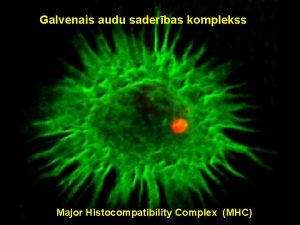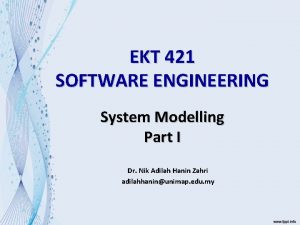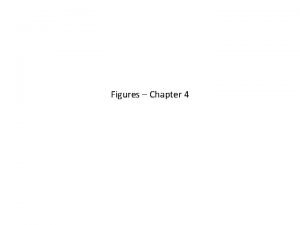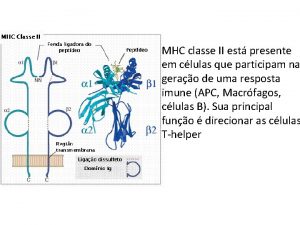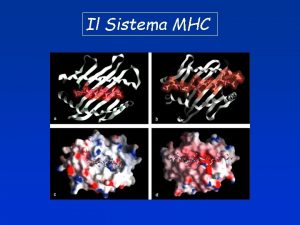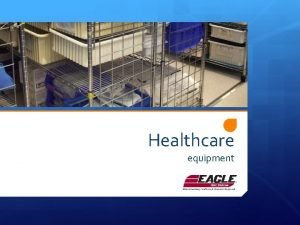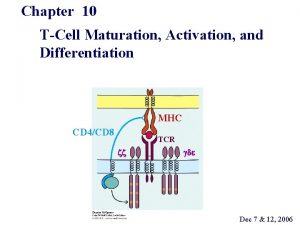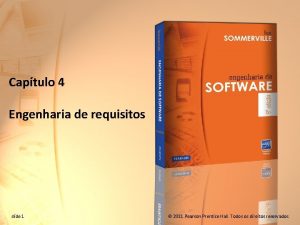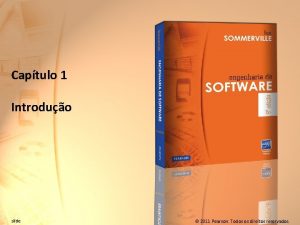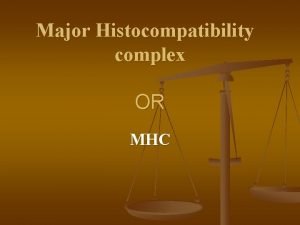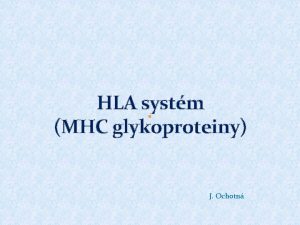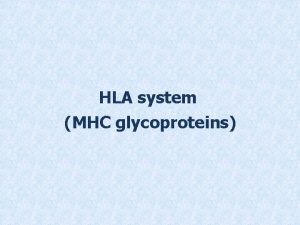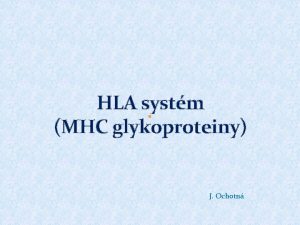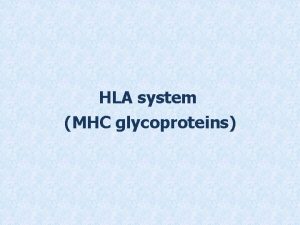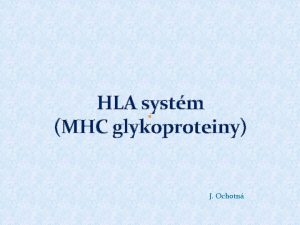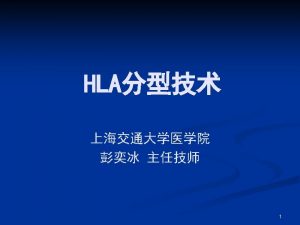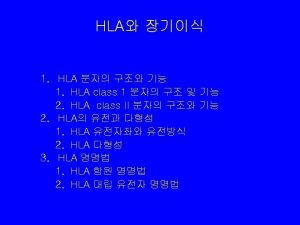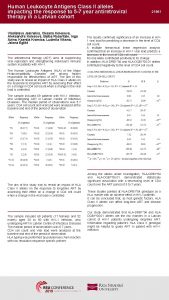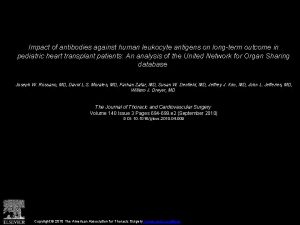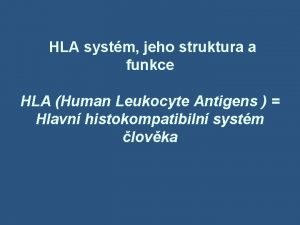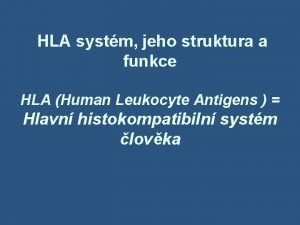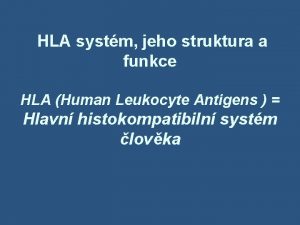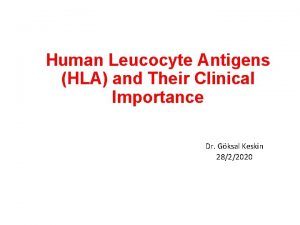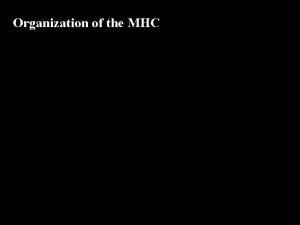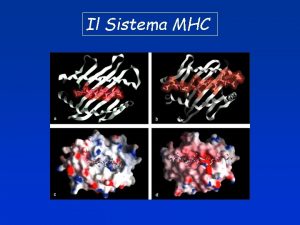HLA antigens Human Leukocyte Antigens human MHC Main












































- Slides: 44

HLA antigens (Human Leukocyte Antigens) = human MHC (Main Histocompatibility Complex) antigens

Polymorphism of human MHC antigens

HLA genes are localized on 6 p chromosome

Co-dominant expression of HLA genes

HLA-I antigens

HLA-II antigens


Binding of antigenic peptide to HLA molecule Downloaded from: Student. Consult (on 18 July 2006 08: 13 AM) © 2005 Elsevier


Interaction of TCR with HLA+antigen Downloaded from: Student. Consult (on 18 July 2006 08: 13 AM) © 2005 Elsevier

Superantigens • Bind to invariant regions of HLA-II and TCR. • The consequence is a polyclonal stimulation of lymphocytes without presence of antigen. • This stimulation may lead to autoimmune reaction. • High quantity of released cytokines may lead to a severe damage of the organism. • Examples: staphylococcal enterotoxin, erytrogenic toxin of Streptococcus toxin streptokoků

Activation of TCR by antigen and by superantigen www. bio. davidson. edu/. . . /restricted/TSS. html

Initiation of the immune response, Role of HLA antigens

Two types of antigens as regards antibody production stimulation • T- dependent. Initiation of immune response requires antigen presenting cells, T-lymphocytes. Includes majority of antigens. • T-independent. For the stimulation of B-cells Tlymphocytes (and APC) are not necessary. Polysacharides are typical examples. Only Ig. M is produced (not other isotypes). No immune memory is induced. • T

Role of HLA antigens in immune response Downloaded from: Student. Consult (on 18 July 2006 08: 13 AM) © 2005 Elsevier

Degradation and presentation of antigens on HLA-II molecules

Role of HLA antigens in immune response • HLA-I: Expressed on all nucleated cells. Presentation of endogenous antigens to CD 8+ cells. This leads to activation of the CD 8+ cell and cytotoxic effect on antigen-presenting cell. • HLA-II Expressed on professional antigenpresenting cells – monocytes, macrophages, dendritic cells, B-cells. Presentation of exogenous antigens to CD 4+ cells. This leads to activation of the CD 4+ (and also the antigen presenting cell).

Stimulation of a T-cell by an antigen is a complex reaction

Costimulatory signals in T-cell activation

Costimulatory signals in T-cell activation

Function of Th 1 cells

Initiation of antibody response in T-cell dependent antigens



Expression of viral antigens on HLA-I molecules

HLA antigens and diseases • Various, predominantly immunopathologic, diseases are more frequent in persons with some HLA antigens. • Presence of the HLA antigen makes a predisposition to development of the disease (increased relative risk), but not cause a disease. • Majority of the carriers of the „disease associated antigen“ are healthy!

Association of diseases with particular HLA antigens

Ankylosing spondylitis • Males predominantly affected, frequency 1: 1000. • Usually starts with sacroileitis, consequently vertebral column is affected. • Fibrotisation and ossification of intervertebral joins and filaments. • The process leads to decreased mobility and ankylosis in terminal state. • Ninety-five percent of patients are HLA-27 positive.

Ankylosing spondylitis

Ankylozing spondylitis and HLA B-27 • Frequency of the disease is 1: 1000. • Ninety-five percent of patients are HLA-27 positive (in Caucasian population). • But: HLA-27 is present in approximately 5% of people Þ only 1 / 50 HLA B-27+ persons will develop ankylosing spondylitis! • Negativity of HLA-B 27 almost excludes the diagnosis of ankylosing spondylitis. • Pozitivity – only shows that the patient has the predisposition! It does not make a diagnosis!

Regulation of the immune response – Interactions of the components of the immune system – Characteristcs of the stimulating antigen (PAMPs, T-dependent and T-independent antigens) – Neuroendocrine interactions

Regulation within the immune system – Physical interactions among cells – through surface molecules transmitting positive or negative signals. – Chemical signals – cytokines, regulation by antibodies (idiotype-antiidiotype interactions)

Costimulatory molecules involved in the interaction between APC and T-lymphocyte Hořejší, Bartůňková: Základy imunologie, 3. vydání, Triton, 2005

Regulation by T-lymphocytes • Relation between Th 1 and Th 2 cells • Various types of regulatory cells

Vzájemné vztahy Th 1 a Th 2 buněk Hořejší, Bartůňková: Základy imunologie, 3. vydání, Triton, 2005

Cytokines • Mediators, „tissue hormons“, main regulators of the cells of the immune system. • Produced mainly by the cells of the immune system, also the cells of the immune system predominate as the target cells. • The effect on the target cell is based on the interaction with specific receptors. • Usually short half-life • Nomenclature: – IL-1 - IL-36 (? ) – Historical names: interferons, TNF, CSF. .

Cytokines • Usually produced by a broad range of cells, bus some cells are usually „main producers“ of the concrete cytokine. . • Pleiotropic effect. • Cytokine network is formed. • A concrete cytokine may have both stimulatory and inhibitory effect, depending on the interaction with other cytokines, concentration of the cytokine….

Interferons (IFN) • Type I: IFN a, IFN b : produced by the virus infected cells (fibroblasts, macrophages). In the target cells they inhibit viral replication. • Type II „Immune“: IFN g: produced by activated TH 1 cells, causes activation of macrophages.

Cytokines in pathogensis of diseases • Atopic diseases: IL-4 stimulates Ig. E production, IL-5 stimulates eosinophils production. • Inflammatory diseases (rheumatic, Crohn´s disease), systemic response in sepsis – various pro -inflammatiory cytokines, TNF-a seems to be the most important. • Immunodeficiency diseases may be caused by disturbed production of various cytokines (IFNg, IL-12), or defect of cytokine receptors.

Therapeutic use of cytokines • IFN-a: anti-tumor treatment (malignancies of the lymphatic system, renal cancer, treatment of hepatitis B and C • IL-2 - anti-tumor treatment • GM-CSF – treatment of granulocytopenia • IFN-b: treatment of multiple sclerosis • IFN-g: treatment of some immunodeficiencies

Effects of cytokines • Pro-inflammatory cytokines: IL-1, IL-6, TNF-a, IL-18 • Stimulation of macrophages: IFN-g • Stimulation of granulocytes: IL-8 • T-lymphocytes stimulation: IL-2 • B-lymphocytes stimulation, production of antibodies: IL-4, IL-5, IL-6, • Progenitor cells proliferation: IL-3, GM-CSF, M -CFS • Negative regulators: IL-10, IL-13, TGF-b

Treg lymphocytes • Separate subgroup of regulatory T-cells • Thymic development, although the development in periphery was also documented. • CD 4+CD 25+ • Suppress immune reaction against self-antigens • 5 -10% of peripheral CD 4+ cells


TR-1 lymphocytes • Induced i periphery by antigen. • CD 4+ • Production of high levels of IL-10, IFN-g, TGF-b, but not IL-2. • Similar function have Th 3 cells
 Hla
Hla Mhc and hla
Mhc and hla Principle of pas staining
Principle of pas staining White blood cells size
White blood cells size Vcayco
Vcayco Ebevlet
Ebevlet Differential leukocyte count (dlc)
Differential leukocyte count (dlc) Leukocyte esterase
Leukocyte esterase Leukocyte removal filter
Leukocyte removal filter Thymus independent antigens
Thymus independent antigens Thymus independent antigens
Thymus independent antigens Precipitation curve immunology
Precipitation curve immunology Blood type antigen chart
Blood type antigen chart Complete antigens
Complete antigens Characteristics of antigen
Characteristics of antigen Palm sunday hla
Palm sunday hla Hla b44 positive
Hla b44 positive Hla 검사 원리
Hla 검사 원리 Ulcerative colitis hla
Ulcerative colitis hla Hla b 27
Hla b 27 Teste schober
Teste schober Hla b27 pozitivita
Hla b27 pozitivita Hla typizace
Hla typizace Hla typizace
Hla typizace Hla b35 artrite psoriasica
Hla b35 artrite psoriasica Hla hameln
Hla hameln Mhc document express support
Mhc document express support Mhc-pms use case diagram
Mhc-pms use case diagram Mhc molecules
Mhc molecules Mhc evolution
Mhc evolution Class i vs class ii mhc
Class i vs class ii mhc Yvv de zwervers- de groote stee
Yvv de zwervers- de groote stee Genetic hitchhiking
Genetic hitchhiking Mhc molekula
Mhc molekula Mhc-pms use case diagram
Mhc-pms use case diagram Point of sale use case diagram
Point of sale use case diagram Mhc-pms meaning
Mhc-pms meaning Mhc-pms in software engineering
Mhc-pms in software engineering Mhc-pms
Mhc-pms Mhc classe 1
Mhc classe 1 Poligenia mhc
Poligenia mhc Eagle mhc
Eagle mhc T cell mhc
T cell mhc Mhc pms
Mhc pms Mhc-pms
Mhc-pms

